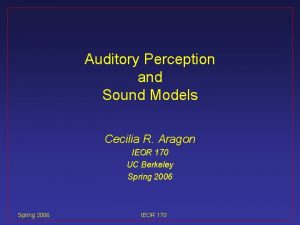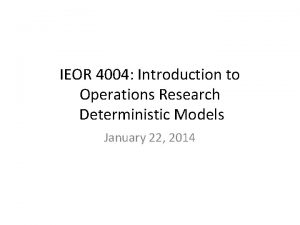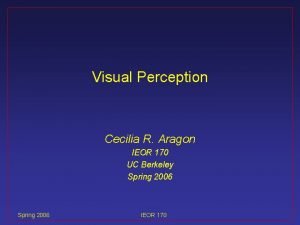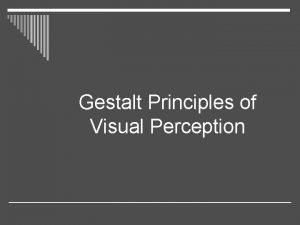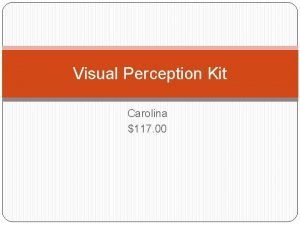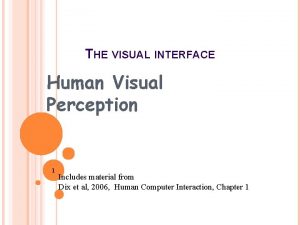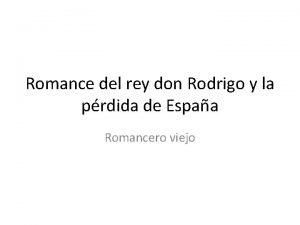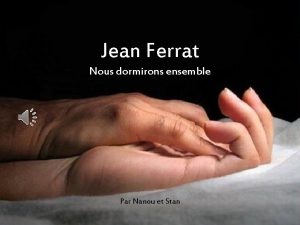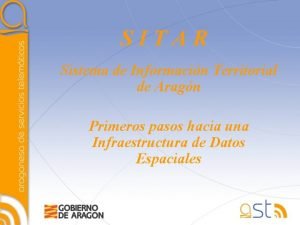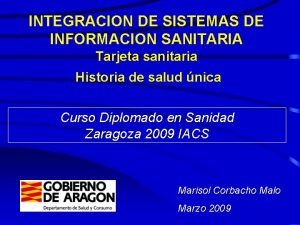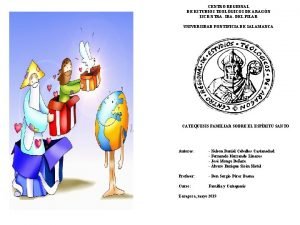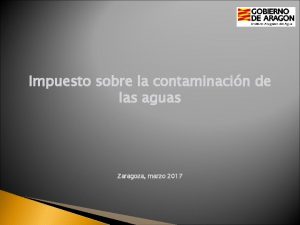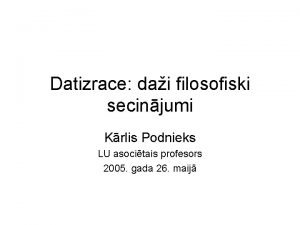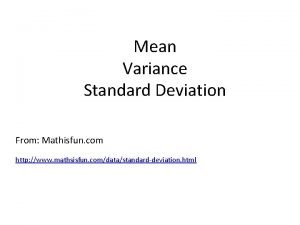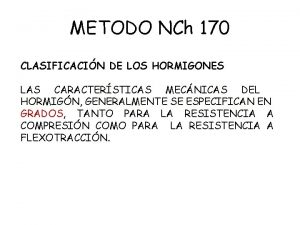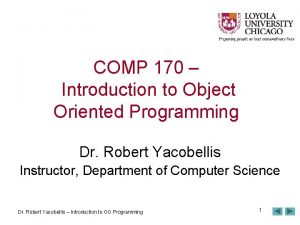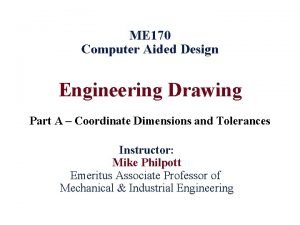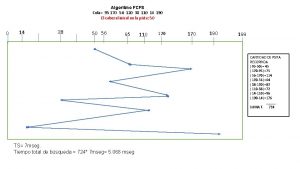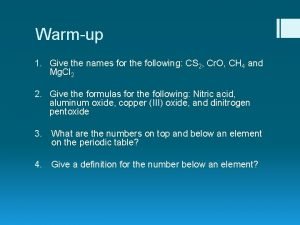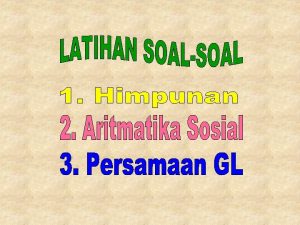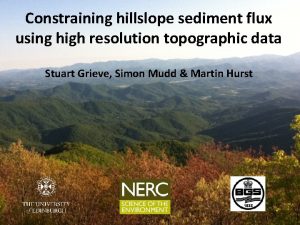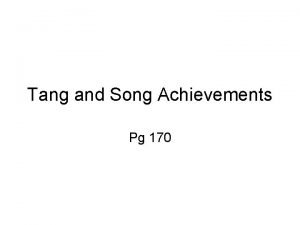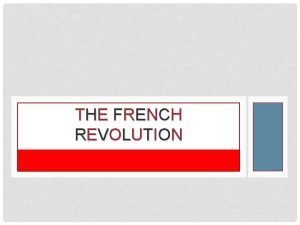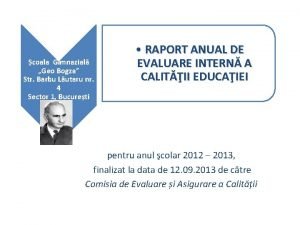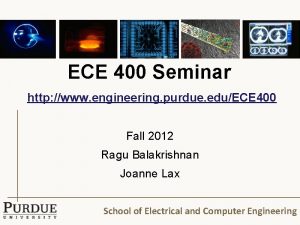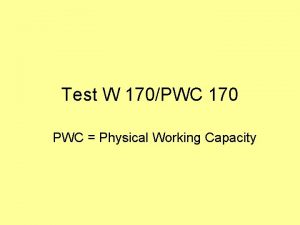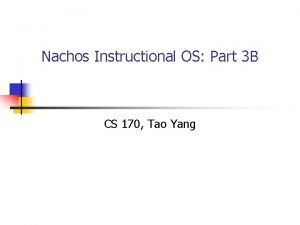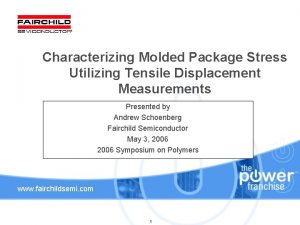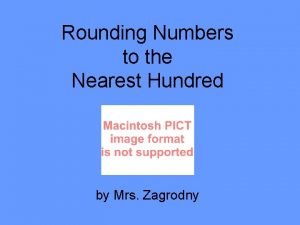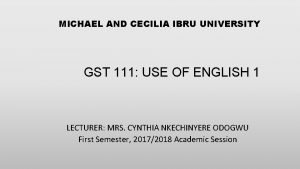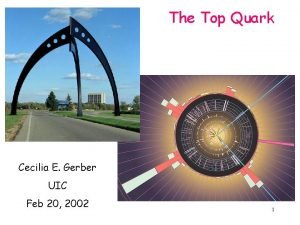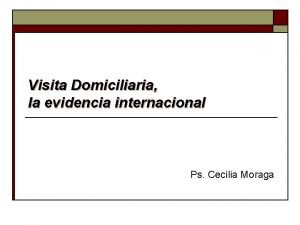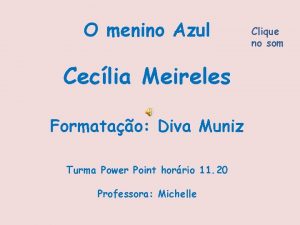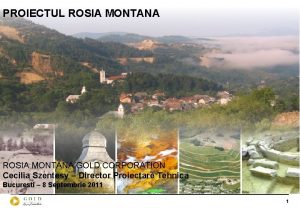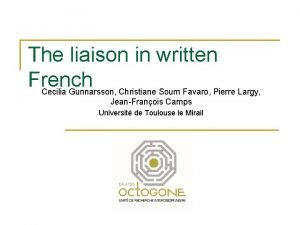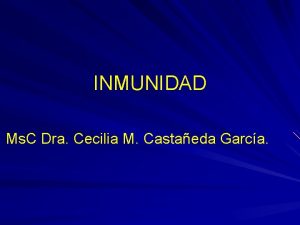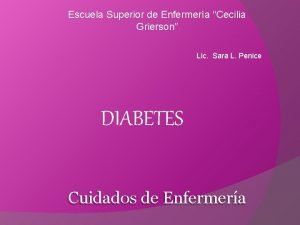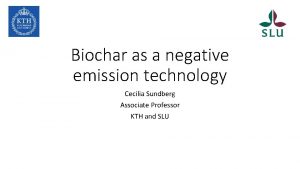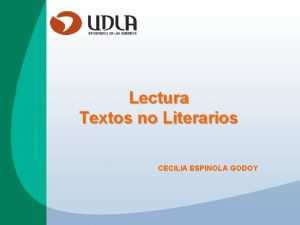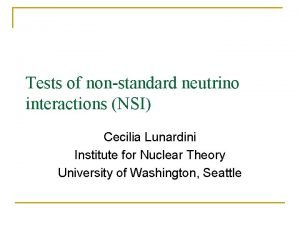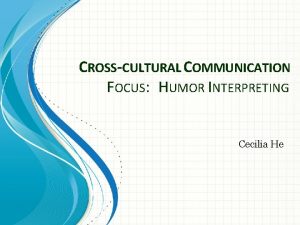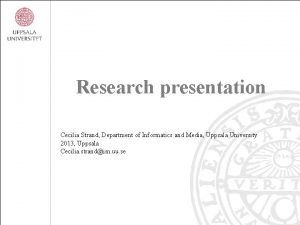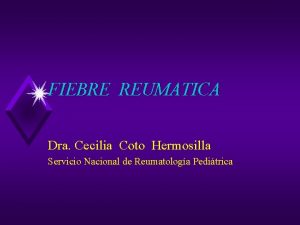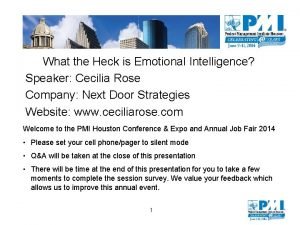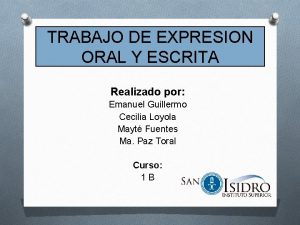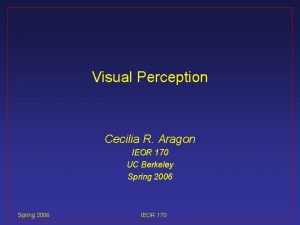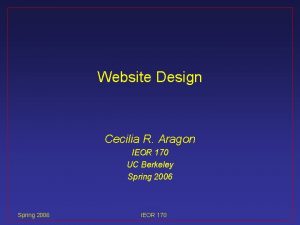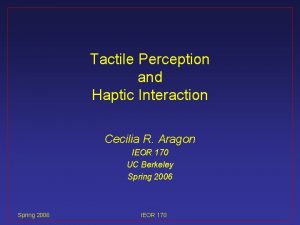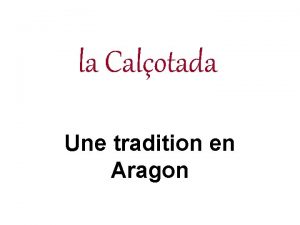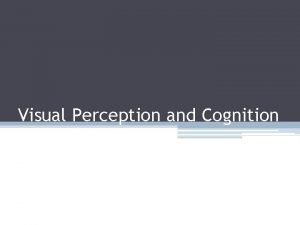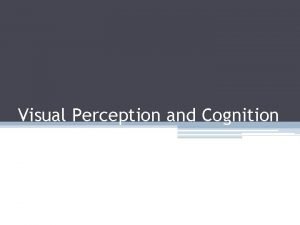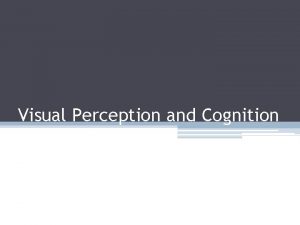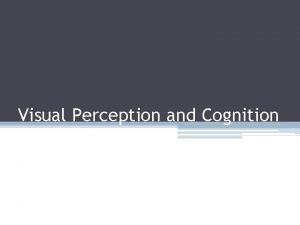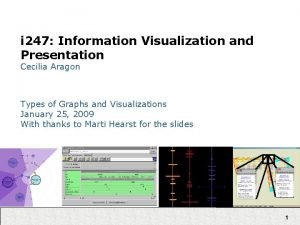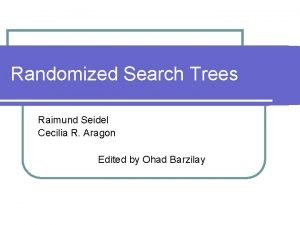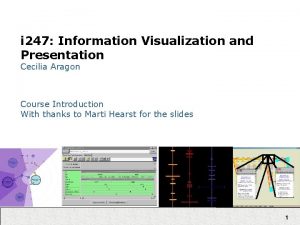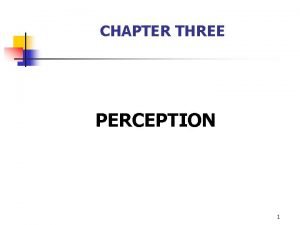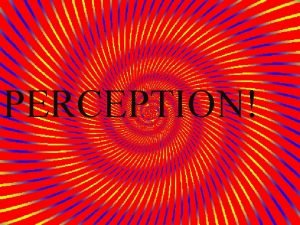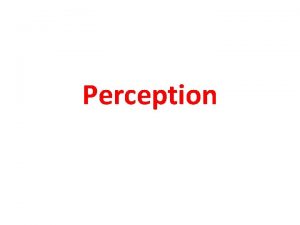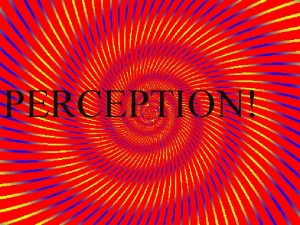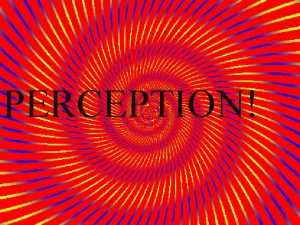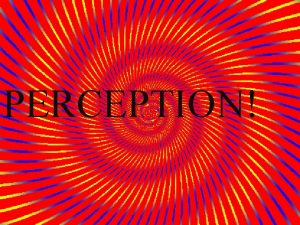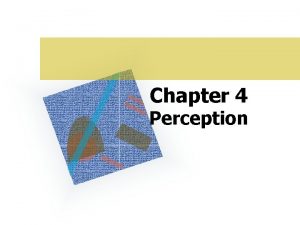Visual Perception Cecilia R Aragon IEOR 170 UC






































![Stevens’ Power Law [Stevens 1961] Spring 2006 IEOR 170 39 Stevens’ Power Law [Stevens 1961] Spring 2006 IEOR 170 39](https://slidetodoc.com/presentation_image_h2/fd81a37160c59cdbdc30801efd4b3544/image-39.jpg)









![Integral vs. Separable Dimensions Integral Separable [Ware 2000] Spring 2006 IEOR 170 49 Integral vs. Separable Dimensions Integral Separable [Ware 2000] Spring 2006 IEOR 170 49](https://slidetodoc.com/presentation_image_h2/fd81a37160c59cdbdc30801efd4b3544/image-49.jpg)













![Examples Proximity Connectedness [from Ware 2004] Figure/Ground [http: //www. aber. ac. uk/media/Modules/MC 10220/visper 07. Examples Proximity Connectedness [from Ware 2004] Figure/Ground [http: //www. aber. ac. uk/media/Modules/MC 10220/visper 07.](https://slidetodoc.com/presentation_image_h2/fd81a37160c59cdbdc30801efd4b3544/image-63.jpg)





















- Slides: 84

Visual Perception Cecilia R. Aragon IEOR 170 UC Berkeley Spring 2006 IEOR 170

Acknowledgments • Thanks to slides and publications by Pat Hanrahan, Christopher Healey, Maneesh Agrawala, and Lawrence Anderson-Huang. Spring 2006 IEOR 170 2

Visual perception • • Structure of the Retina Preattentive Processing Detection Estimating Magnitude Change Blindness Multiple Attributes Gestalt Spring 2006 IEOR 170 3

Visual perception and psychophysics Psychophysics is concerned with establishing quantitative relations between physical stimulation and perceptual events. Spring 2006 IEOR 170 4

Structure of the Retina Spring 2006 IEOR 170 5

Structure of the Retina • The retina is not a camera! • Network of photo-receptor cells (rods and cones) and their connections [Anderson-Huang, L. http: //www. physics. utoledo. edu/~lsa/ _color/18_retina. htm] Spring 2006 IEOR 170 6

Photo-transduction • When a photon enters a receptor cell (e. g. a rod or cone), it is absorbed by a molecule called 11 cis-retinal and converted to trans form. • The different shape causes it to ultimately reduce the electrical conductivity of the photo-receptor cell. [Anderson-Huang, L. http: //www. physics. utoledo. edu/~lsa/_color/18_retina. htm] Spring 2006 IEOR 170 7

Electric currents from photo-receptors • Photo-receptors generate an electrical current in the dark. • Light shuts off the current. • Each doubling of light causes roughly the same reduction of current (3 pico. Amps for cones, 6 for rods). • Rods more sensitive, recover more slowly. • Cones recover faster, overshoot. • Geometrical response in scaling laws of perception. Spring 2006 [Anderson-Huang, L. http: //www. physics. utoledo. edu/~lsa/_color/18_retina. htm] IEOR 170 8

Preattentive Processing Spring 2006 IEOR 170

How many 5’s? 385720939823728196837293827 382912358383492730122894839 909020102032893759273091428 938309762965817431869241024 [Slide adapted from Joanna Mc. Grenere http: //www. cs. ubc. ca/~joanna/ ] Spring 2006 IEOR 170 10

How many 5’s? 385720939823728196837293827 382912358383492730122894839 909020102032893759273091428 938309762965817431869241024 Spring 2006 IEOR 170 11

Preattentive Processing • Certain basic visual properties are detected immediately by low-level visual system • “Pop-out” vs. serial search • Tasks that can be performed in less than 200 to 250 milliseconds on a complex display • Eye movements take at least 200 msec to initiate Spring 2006 IEOR 170 12

Color (hue) is preattentive • Detection of red circle in group of blue circles is preattentive [image from Healey 2005] Spring 2006 IEOR 170 13

Form (curvature) is preattentive • Curved form “pops out” of display [image from Healey 2005] Spring 2006 IEOR 170 14

Conjunction of attributes • Conjunction target generally cannot be detected preattentively (red circle in sea of red square and blue circle distractors) [image from Healey 2005] Spring 2006 IEOR 170 15

Healey applet on preattentive processing http: //www. csc. ncsu. edu/faculty/healey/PP/index. html Spring 2006 IEOR 170 16

Preattentive Visual Features line orientation length width size curvature number terminators intersection Spring 2006 closure color (hue) intensity flicker direction of motion stereoscopic depth 3 D depth cues IEOR 170 17

line (blob) orientation Spring 2006 IEOR 170 18

length, width Spring 2006 IEOR 170 19

closure Spring 2006 IEOR 170 20

size Spring 2006 IEOR 170 21

curvature Spring 2006 IEOR 170 22

density, contrast Spring 2006 IEOR 170 23

intersection Spring 2006 IEOR 170 24

terminators Spring 2006 IEOR 170 25

flicker Spring 2006 IEOR 170 26

direction of motion Spring 2006 IEOR 170 27

velocity of motion Spring 2006 IEOR 170 28

Cockpit dials • Detection of a slanted line in a sea of vertical lines is preattentive Spring 2006 IEOR 170 29

Detection Spring 2006 IEOR 170 30

Just-Noticeable Difference • Which is brighter? Spring 2006 IEOR 170 31

Just-Noticeable Difference • Which is brighter? (130, 130) Spring 2006 (140, 140) IEOR 170 32

Weber’s Law • In the 1830’s, Weber made measurements of the justnoticeable differences (JNDs) in the perception of weight and other sensations. • He found that for a range of stimuli, the ratio of the JND ΔS to the initial stimulus S was relatively constant: ΔS / S = k Spring 2006 IEOR 170 33

Weber’s Law • Ratios more important than magnitude in stimulus detection • For example: we detect the presence of a change from 100 cm to 101 cm with the same probability as we detect the presence of a change from 1 to 1. 01 cm, even though the discrepancy is 1 cm in the first case and only. 01 cm in the second. Spring 2006 IEOR 170 34

Weber’s Law • Most continuous variations in magnitude are perceived as discrete steps • Examples: contour maps, font sizes Spring 2006 IEOR 170 35

Estimating Magnitude Spring 2006 IEOR 170 36

Stevens’ Power Law • Compare area of circles: Spring 2006 IEOR 170 37

Stevens’ Power Law s(x) = axb s is the sensation x is the intensity of the attribute a is a multiplicative constant b is the power b > 1: overestimate b < 1: underestimate Spring 2006 [graph from Wilkinson 99] IEOR 170 38
![Stevens Power Law Stevens 1961 Spring 2006 IEOR 170 39 Stevens’ Power Law [Stevens 1961] Spring 2006 IEOR 170 39](https://slidetodoc.com/presentation_image_h2/fd81a37160c59cdbdc30801efd4b3544/image-39.jpg)
Stevens’ Power Law [Stevens 1961] Spring 2006 IEOR 170 39

Stevens’ Power Law Experimental results for b: Length Area Volume . 9 to 1. 1. 6 to. 9. 5 to. 8 Heuristic: b ~ 1/sqrt(dimensionality) Spring 2006 IEOR 170 40

Stevens’ Power Law • Apparent magnitude scaling [Cartography: Thematic Map Design, p. 170, Dent, 96] S = 0. 98 A 0. 87 [J. J. Flannery, The relative effectiveness of some graduated point symbols in the presentation of quantitative data, Canadian Geographer, 8(2), pp. 96 -109, 1971] [slide from Pat Hanrahan] Spring 2006 IEOR 170 41

Relative Magnitude Estimation Most accurate Position (common) scale Position (non-aligned) scale Length Slope Angle Least accurate Spring 2006 Area Volume Color (hue/saturation/value) IEOR 170 42

Change Blindness Spring 2006 IEOR 170 43

Change Blindness • An interruption in what is being seen causes us to miss significant changes that occur in the scene during the interruption. • Demo from Ron Rensink: http: //www. psych. ubc. ca/~rensink/flicker/ Spring 2006 IEOR 170 44

Possible Causes of Change Blindness [Simons, D. J. (2000), Current approaches to change blindness, Visual Cognition, 7, 1 -16. ] Spring 2006 IEOR 170 45

Multiple Visual Attributes Spring 2006 IEOR 170 46

The Game of Set • • Color Symbol Number Shading A set is 3 cards such that each feature is EITHER the same on each card OR is different on each card. [Set applet by Adrien Treuille, http: //www. cs. washington. edu/homes/treuille/resc/set/] Spring 2006 IEOR 170 47

Multiple Visual Attributes • Integral vs. separable · Integral dimensions · two or more attributes of an object are perceived holistically (e. g. width and height of rectangle). · Separable dimensions · judged separately, or through analytic processing (e. g. diameter and color of ball). • Separable dimensions are orthogonal. • For example, position is highly separable from color. In contrast, red and green hue perceptions tend to interfere with each other. Spring 2006 IEOR 170 48
![Integral vs Separable Dimensions Integral Separable Ware 2000 Spring 2006 IEOR 170 49 Integral vs. Separable Dimensions Integral Separable [Ware 2000] Spring 2006 IEOR 170 49](https://slidetodoc.com/presentation_image_h2/fd81a37160c59cdbdc30801efd4b3544/image-49.jpg)
Integral vs. Separable Dimensions Integral Separable [Ware 2000] Spring 2006 IEOR 170 49

Gestalt Spring 2006 IEOR 170 50

Spring 2006 IEOR 170 51

Gestalt • This law says that we try to experience things in as good a gestalt way as possible. In this sense, "good" can mean several things, such as regular, orderly, simplistic, symmetrical, etc. The other gestalt laws are: Spring 2006 IEOR 170 52

Gestalt Principles • • • figure/ground proximity similarity symmetry connectedness continuity closure common fate transparency Spring 2006 IEOR 170 53

Figure-ground • Figure-ground minds have an innate tendency to perceive one aspect of an event as the figure or foreground and the other as the ground or the background. Spring 2006 IEOR 170 54

proximity Spring 2006 IEOR 170 55

similarity Spring 2006 IEOR 170 56

symmetry Spring 2006 IEOR 170 57

connectedness Spring 2006 IEOR 170 58

continuity Spring 2006 IEOR 170 59

closure Spring 2006 IEOR 170 60

Classical Principles of Grouping (I) Spring 2006 IEOR 170 61

Classical Principles of Grouping (II) Spring 2006 IEOR 170 62
![Examples Proximity Connectedness from Ware 2004 FigureGround http www aber ac ukmediaModulesMC 10220visper 07 Examples Proximity Connectedness [from Ware 2004] Figure/Ground [http: //www. aber. ac. uk/media/Modules/MC 10220/visper 07.](https://slidetodoc.com/presentation_image_h2/fd81a37160c59cdbdc30801efd4b3544/image-63.jpg)
Examples Proximity Connectedness [from Ware 2004] Figure/Ground [http: //www. aber. ac. uk/media/Modules/MC 10220/visper 07. html] Spring 2006 IEOR 170 63

Visual Completion Spring 2006 IEOR 170 64

Edge Relatability Spring 2006 IEOR 170 65

Illusory Contours 5. 3. 2 Spring 2006 IEOR 170 66

Illusory Contours (II) Spring 2006 IEOR 170 67

Depth perception • Oculomotor • Visual – Acoomodation – Covegence • muscle feedback • control signal – Binocular – Monocular • Static cues – Interposition – Size – Perspective • Motion parallax Spring 2006 IEOR 170 68

Depth perception – Perspective • Linear perspective • Texture gradient • Aerial-perspective • Shadow Spring 2006 IEOR 170 69

Size Spring 2006 IEOR 170 70

Spring 2006 IEOR 170 71

Spring 2006 IEOR 170 72

Spring 2006 IEOR 170 73

Linear perspective Spring 2006 IEOR 170 74

Aerial Perspective Spring 2006 IEOR 170 75

Texture gradient Spring 2006 IEOR 170 76

Shades and Shadows Spring 2006 IEOR 170 77

Shades and Shadows Spring 2006 IEOR 170 78

Overlapping Spring 2006 IEOR 170 79

Motion Spring 2006 IEOR 170 80

motion parallax Spring 2006 IEOR 170 81

Spring 2006 IEOR 170 82

Conclusion · What is currently known about visual perception can aid the design process. · Understanding low-level mechanisms of the visual processing system and using that knowledge can result in improved displays. Spring 2006 IEOR 170 83

Spring 2006 IEOR 170 84
 Ieor 170
Ieor 170 Ieor 4004
Ieor 4004 Ieor 130
Ieor 130 Ieor 115
Ieor 115 Visual
Visual Principles of visual perception
Principles of visual perception Carolina visual perception kit
Carolina visual perception kit Visual perception in hci
Visual perception in hci Villa era el seudónimo de doroteo aragón
Villa era el seudónimo de doroteo aragón Romance de don rodrigo y la cava
Romance de don rodrigo y la cava Universidad alher aragón
Universidad alher aragón Catherine of aragon descendants
Catherine of aragon descendants Miguel aragon
Miguel aragon J'ai mis mon coeur entre tes mains
J'ai mis mon coeur entre tes mains Visor infogis aragón incendios
Visor infogis aragón incendios Aragón medence
Aragón medence Muface murcia
Muface murcia Centro regional de estudios teológicos de aragón
Centro regional de estudios teológicos de aragón Desiree aragon
Desiree aragon Pregonadas son las guerras de francia con aragón
Pregonadas son las guerras de francia con aragón Servicios aragon es eac webpeac
Servicios aragon es eac webpeac Icagestionaragon
Icagestionaragon Did henry viii divorce catherine of aragon
Did henry viii divorce catherine of aragon Orden del 16 de junio de 2014
Orden del 16 de junio de 2014 Servicios aragon es eac webpeac
Servicios aragon es eac webpeac 1629-1695
1629-1695 Mathisfun mean median mode
Mathisfun mean median mode If an aquarium holds 80 l of water and contains 170 guppies
If an aquarium holds 80 l of water and contains 170 guppies Hormigon h15
Hormigon h15 Comp170
Comp170 Drill depth symbol
Drill depth symbol 6-4 work together p. 170
6-4 work together p. 170 Scan algoritmo
Scan algoritmo A 170 g sample of an unidentified compound contains
A 170 g sample of an unidentified compound contains S = bilangan asli
S = bilangan asli Trc-170 technical manual
Trc-170 technical manual 350-170-120
350-170-120 730-170
730-170 Song dynasty accomplishments
Song dynasty accomplishments Nch 170
Nch 170 21cfr211.170
21cfr211.170 Scoala 170
Scoala 170 An/trc-170 troposcatter system
An/trc-170 troposcatter system Rangos ci decreto 170
Rangos ci decreto 170 Ee 170 purdue
Ee 170 purdue Numberblocks 170
Numberblocks 170 Pwc 170 test
Pwc 170 test 25 cfr 170
25 cfr 170 Nachos
Nachos 170 mpa
170 mpa Round 170 to the nearest hundred
Round 170 to the nearest hundred Gst 111 communication in english
Gst 111 communication in english Cecilia gerber
Cecilia gerber Cecilia moraga
Cecilia moraga Vulvitis herpetica
Vulvitis herpetica Cecilia brioni
Cecilia brioni Maria cecilia luise
Maria cecilia luise Cecilia bailliet
Cecilia bailliet Antonio skarmeta biografia
Antonio skarmeta biografia Cecília meireles poemas curtos
Cecília meireles poemas curtos Cecilia cunningham
Cecilia cunningham O menino azul cecília meireles
O menino azul cecília meireles A song for st cecilia's day by john dryden
A song for st cecilia's day by john dryden Cecilia montana
Cecilia montana Cecilia gunnarsson
Cecilia gunnarsson Dr varjú cecília
Dr varjú cecília Cecilia lodi
Cecilia lodi Stanchi cecilia ig
Stanchi cecilia ig Escuela de enfermeria cecilia grierson
Escuela de enfermeria cecilia grierson Cecilia sundberg
Cecilia sundberg Usenet message cecilia
Usenet message cecilia Cecilia espinola
Cecilia espinola Earth day
Earth day Cecilia he
Cecilia he Una carretera pasa por las ciudades p q r y s
Una carretera pasa por las ciudades p q r y s Cecilia ventura
Cecilia ventura Cecilia ritchie
Cecilia ritchie Cecilia strand
Cecilia strand Cecilia tinonin
Cecilia tinonin Cecilia del toro
Cecilia del toro Amigdalitits
Amigdalitits Colangiohepatitis
Colangiohepatitis Emotional intelligence speaker
Emotional intelligence speaker Cecilia gallego
Cecilia gallego Cecilia loyola
Cecilia loyola
